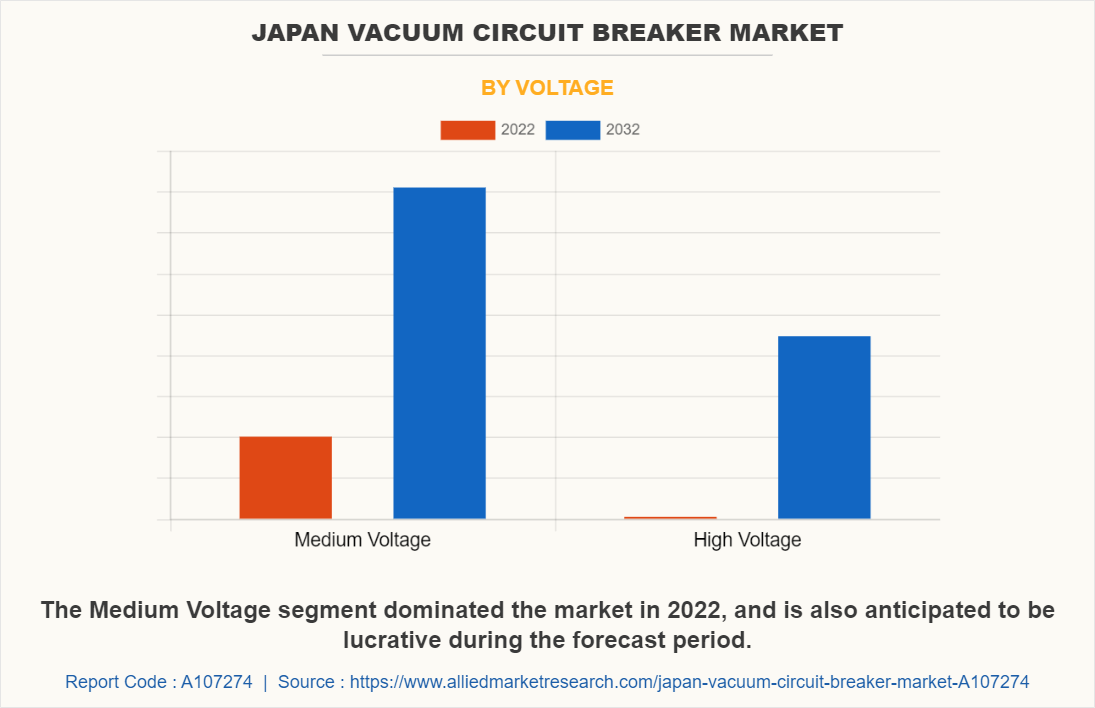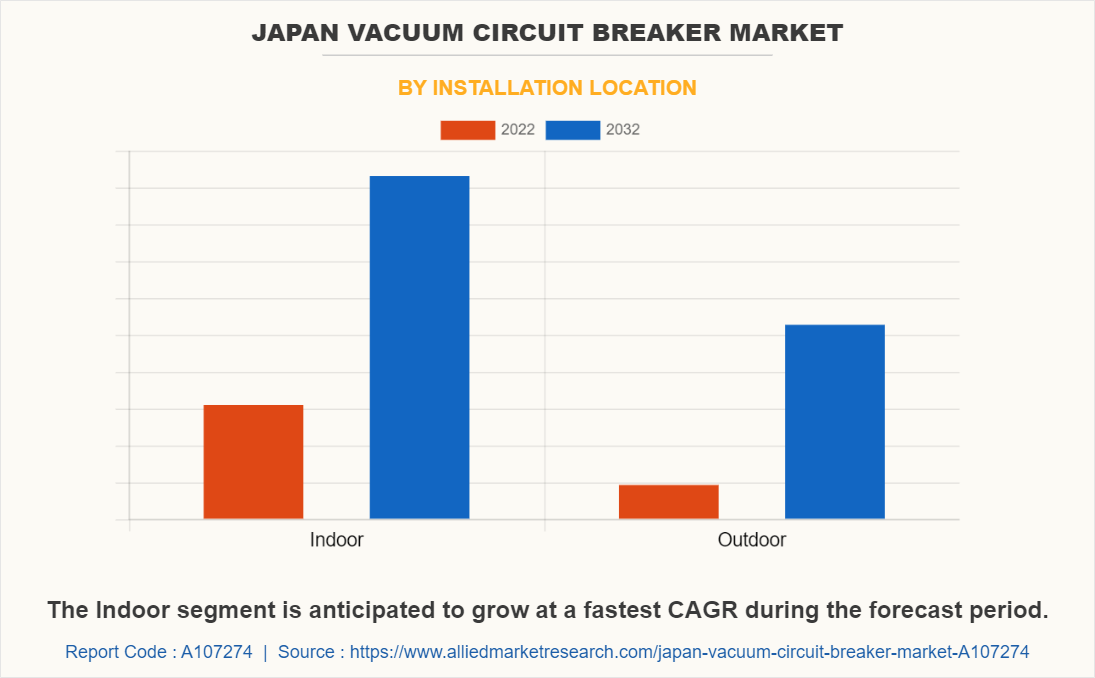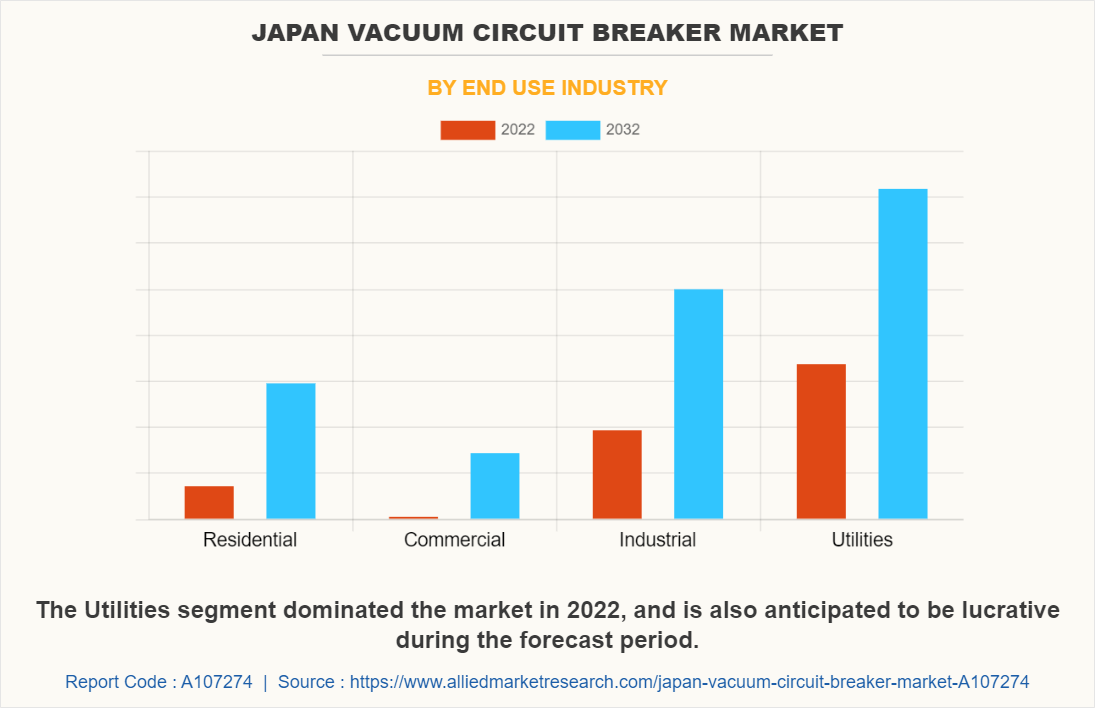The Japan Vacuum Circuit Breaker market, a dynamic and intricate realm, is shaped by multiple factors, each weaving its own complex thread into the overarching tapestry of the industry. Voltage, installation location, and end-use industry stand as three pivotal facets that define the market's trajectory. While delving into this enigmatic landscape, we shall explore the market dynamics, shedding light on driving factors, restraining elements, and the myriad opportunities that beckon like distant constellations. The Japan Vacuum Circuit Breaker market dances to the tune of multifarious dynamics, driven by a harmonious interplay of elements. At the heart of this ecosystem lie the market's driving factors, akin to a powerful locomotive propelling the industry forward. The need for reliable and efficient power distribution systems, especially in the wake of rapid urbanization, constitutes one such factor. In an era where downtime is the adversary of productivity, the vacuum circuit breaker emerges as a steadfast sentinel, safeguarding against electrical disruptions and potential damage. Its impeccable capability to interrupt electric currents provides a dependable solution for industries where precision and continuity are paramount. This inherent reliability in power distribution endears vacuum circuit breakers to the industrial, commercial, and utility sectors.

The surge in Japan's construction activities further stokes the demand for vacuum circuit breakers. As infrastructure takes root and expands across the archipelago, the installation of these breakers becomes an indispensable component in ensuring safe, uninterrupted power supply. The medium voltage segment, in particular, experiences substantial traction in this context, as it caters to a broad spectrum of applications across residential, commercial, industrial, and utility sectors. However, the market, like any other, is not without its set of restraints, acting as tributaries that can divert its course. One such force comes from the complexity of these circuit breakers themselves. While their intricate design is a boon in terms of functionality, it poses challenges in terms of maintenance and repair. Technicians require specialized knowledge and tools to effectively service these circuit breakers, adding to operational costs. This, in turn, calls for significant investments in training and maintenance infrastructure, especially for industries heavily reliant on vacuum circuit breakers. Additionally, the initial cost of these high-performance circuit breakers can be a deterrent for smaller enterprises.

In the labyrinth of the Japan Vacuum Circuit Breaker market, opportunities abound, concealed beneath the surface, waiting for the astute observer to unearth. One such opportunity resides in the ever-evolving landscape of technology. The amalgamation of vacuum circuit breakers with smart grid systems ushers in a new era of energy management. As Japan strives to enhance energy efficiency and minimize wastage, the role of vacuum circuit breakers in optimizing power distribution becomes pivotal. These breakers, when equipped with monitoring and control features, offer the ability to respond to real-time data, thereby improving system reliability and reducing downtime. Furthermore, the market's segmentation along the lines of installation location allows for targeted opportunities. The distinction between indoor and outdoor installation is significant, especially in regions prone to natural calamities such as earthquakes and typhoons. For industries that must endure the wrath of Mother Nature, outdoor installation of vacuum circuit breakers becomes an attractive option, as it provides enhanced protection against environmental factors. The residential sector, though often overshadowed by its industrial and commercial counterparts, presents a unique opportunity in the Japan Vacuum Circuit Breaker market. As smart home technologies continue to gain traction, homeowners are increasingly aware of the need for advanced power distribution systems that safeguard their investments. Vacuum circuit breakers tailored for residential use, with user-friendly interfaces and enhanced safety features, are poised for growth.

The Japan Vacuum Circuit Breaker market, as a tapestry of complexity and uncertainty, unfolds future trends that require astute comprehension. First and foremost, the market's reliance on technological advancement is an undeniable trajectory. The incorporation of advanced materials and designs to enhance the performance of vacuum circuit breakers will continue to be a dominant trend. Miniaturization and increased modularity are likely to follow, allowing for more flexible and space-efficient installations. In terms of regulations, as Japan seeks to bolster its energy infrastructure and achieve greater efficiency, stricter regulations concerning power distribution and safety are anticipated. This will necessitate adherence to international standards and practices, creating both opportunities and challenges for market players. A comprehensive segmental overview of the market reveals that the high voltage segment is poised for robust growth. With the industrial and utility sectors undergoing expansion and modernization, high voltage vacuum circuit breakers will experience surging demand. These robust breakers find applications in critical installations such as power plants and substations.

The market scenario in Japan for vacuum circuit breakers is characterized by a dynamic interplay of supply and demand forces. With growing urbanization and industrialization, the market is witnessing a steady surge in demand. The need for reliable power distribution solutions in the face of increased power consumption further fuels this growth. The medium voltage segment, catering to a wide range of applications across industries, stands as a significant contributor to market expansion. The growth trajectory of the Japan Vacuum Circuit Breaker market is expected to continue its upward curve. As industries and utilities recognize the value of uninterrupted power supply, the demand for these circuit breakers will remain robust. The opportunity to harness emerging technologies and meet stringent regulatory standards will be pivotal in shaping this trajectory.
The Japan Vacuum Circuit Breaker market beckons with a wealth of qualitative insights that resonate through every facet of the industry. One of the most pivotal aspects is the continuous emphasis on research and development. As market players endeavor to outshine each other, substantial investments in R&D have become commonplace. The drive for innovation is relentless, seeking to design circuit breakers that are not only more efficient but also eco-friendly. The integration of sustainable materials and practices is a growing concern, aligning with Japan's commitment to environmental conservation.
Consumer and end-user perceptions are an enigmatic aspect of the market. As the populace becomes increasingly aware of the importance of reliable power distribution, their expectations are on the rise. Vacuum circuit breakers that offer superior safety, enhanced functionality, and are easy to use will capture the market's imagination. Understanding and responding to these evolving consumer sentiments is crucial for market players. Pricing strategies adopted by companies within the market are a fascinating realm of study. The delicate balance between offering a competitive price point while ensuring profitability is an ongoing challenge. Market players must be attuned to the cost structures and pricing strategies of their competitors, ensuring they stay relevant in this highly competitive landscape.
Porter's Five Forces Analysis offers a lens through which to view the competitive dynamics of the Japan Vacuum Circuit Breaker market. The first force, the bargaining power of suppliers, is a crucial element. Given the complex nature of these circuit breakers, suppliers hold a significant position in the market. High-quality materials and components are paramount for ensuring the reliability and longevity of vacuum circuit breakers. Therefore, the relationship between manufacturers and suppliers becomes vital in determining the quality of the end product.
The bargaining power of buyers is another pivotal force. Buyers, ranging from industries to residential consumers, have a multitude of options to choose from. This dynamic drives market players to continually innovate and enhance their offerings to stay competitive. The threat of new entrants is moderated by the high barriers to entry. The intricate technology and specialized knowledge required to manufacture vacuum circuit breakers deter new players from entering the market. Additionally, the need for adherence to stringent regulations and industry standards further fortifies these barriers. The threat of substitute products is a notable factor, as alternative circuit breaker technologies exist. However, the reliability and efficiency of vacuum circuit breakers continue to position them as the preferred choice for critical power distribution applications. Finally, the intensity of competitive rivalry is high within the Japan Vacuum Circuit Breaker market. Numerous established players vying for market share, striving to outperform each other through innovation, pricing, and service offerings. This fierce competition benefits consumers and fosters an environment of continuous improvement and technological advancement.
In conclusion, the Japan Vacuum Circuit Breaker market is an intricate realm of dynamics, opportunities, and challenges. Its future trends are woven with the threads of technology, regulations, and segmentation, driving the market's scenario and growth. Qualitative insights emphasize the importance of research and development, consumer perceptions, and pricing strategies. Porter's Five Forces and SWOT analyses unveil the competitive landscape and internal factors that shape the market. This intricate landscape, filled with complexities and uncertainties, continues to evolve, offering both challenges and opportunities for market players to navigate.
Key Benefits For Stakeholders
- Enable informed decision-making process and offer market analysis based on current market situation and estimated future trends.
- Analyze the key strategies adopted by major market players in Japan vacuum circuit breaker market.
- Assess and rank the top factors that are expected to affect the growth of Japan vacuum circuit breaker market.
- Top Player positioning provides a clear understanding of the present position of market players.
- Detailed analysis of the Japan vacuum circuit breaker market segmentation assists to determine the prevailing market opportunities.
- Identify key investment pockets for various offerings in the market.
Japan Vacuum Circuit Breaker Market Report Highlights
| Aspects | Details |
| Forecast period | 2022 - 2032 |
| Report Pages | 90 |
| By Voltage |
|
| By Installation Location |
|
| By End Use Industry |
|
| Key Market Players | Tavrida Electric, Crompton Greaves, Siemens, Schneider Electric, Fuji Electric, Meidensha Corporation, ABB, Hitachi, Toshiba, Mitsubishi Electric |
The Japan Vacuum Circuit Breaker Market is projected to grow at a CAGR of 5.78% from 2022 to 2032
Hitachi, Toshiba, Mitsubishi Electric, Fuji Electric, Meidensha Corporation, ABB, Schneider Electric, Siemens, Tavrida Electric, and Crompton Greaves are the leading players in Japan Vacuum Circuit Breaker Market
1. Enable informed decision-making process and offer market analysis based on current market situation and estimated future trends.
2. Analyze the key strategies adopted by major market players in japan vacuum circuit breaker market.
3. Assess and rank the top factors that are expected to affect the growth of japan vacuum circuit breaker market.
4. Top Player positioning provides a clear understanding of the present position of market players.
5. Detailed analysis of the japan vacuum circuit breaker market segmentation assists to determine the prevailing market opportunities.
6. Identify key investment pockets for various offerings in the market.
Japan Vacuum Circuit Breaker Market is classified as by voltage, by installation location, by end use industry
Loading Table Of Content...
Loading Research Methodology...



